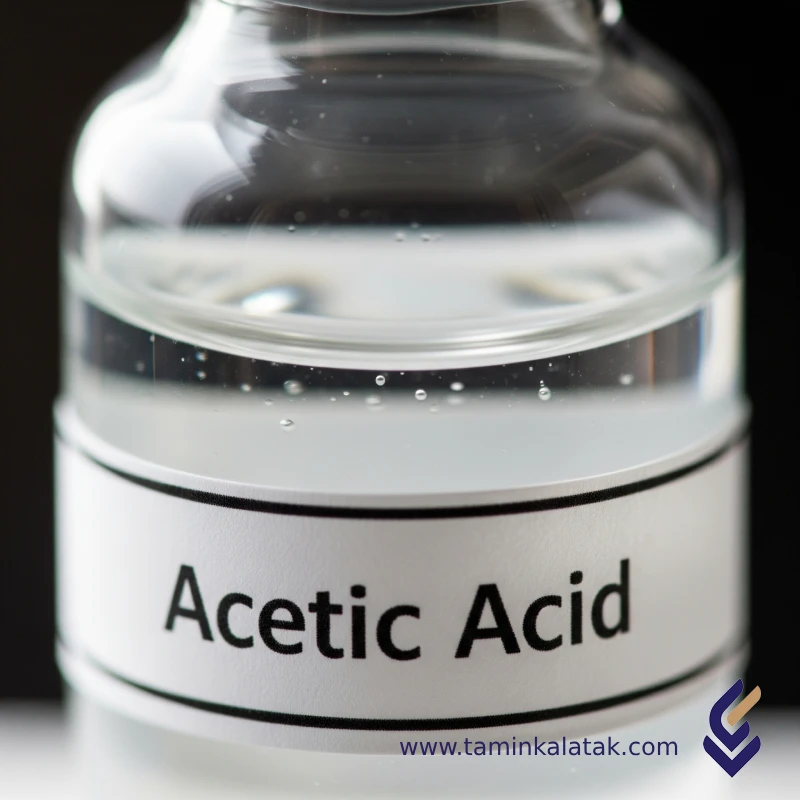Acetic Acid
Acetic Acid (CH₃COOH) is one of the simplest and most widely used carboxylic acids. Also known as vinegar essence or ethanoic acid, it is the main component of edible vinegar, responsible for its sour taste. At room temperature, acetic acid appears as a colorless liquid with a sharp, pungent odor. Due to its unique physical and chemical properties, acetic acid has broad applications across many industries.
Structure of Acetic Acid
The molecular structure of acetic acid consists of a methyl group (−CH₃) and a carboxyl group (−COOH), connected by a carbon–carbon bond.
The carboxyl group is responsible for the acidic properties of the compound because it can release a proton (H⁺) in aqueous solutions.
Physical and Chemical Properties of Acetic Acid
| Property | Description |
|---|---|
| Physical state | Colorless liquid at room temperature |
| Melting point | 16.6°C – Below this temperature, it solidifies into crystalline form known as glacial acetic acid |
| Boiling point | 118–119°C at 1 atm |
| Odor | Sharp, pungent, vinegar-like (irritating at high concentrations) |
| Solubility | Completely miscible with water, alcohols, ethers, and most polar organic solvents |
| Acidity (pKa) | ≈ 4.76 – weak acid, partially ionized in aqueous solution |
| Corrosiveness | Corrosive at high concentrations; may cause chemical burns to skin and eyes |
| Flammability | Flammable; vapors can form explosive mixtures with air |
| Density | ~1.049 g/cm³ at 25°C |
Applications of Acetic Acid
Acetic acid is a versatile reagent and solvent, playing a vital role in many industrial and laboratory processes.
1. Chemical Industry
-
Vinyl Acetate Monomer (VAM) production: Used to manufacture adhesives, resins, and polymers.
-
Synthesis of acetate esters such as:
-
Ethyl acetate: solvent in nail polish remover, paints, and adhesives.
-
Butyl acetate: solvent in inks and coatings.
-
-
Purified Terephthalic Acid (PTA) synthesis: key precursor for PET plastics and polyester fibers.
2. Pharmaceutical Industry
-
Intermediate in the synthesis of drugs, antibiotics, and biological compounds.
3. Textile Industry
-
Acts as a pH regulator and color fixative in dyeing and printing processes.
4. Food Industry
-
Functions as an acidity regulator and preservative (food additive code E260).
-
Primary component of vinegar and flavoring agent in sauces, pickles, and canned foods.
5. Rubber and Plastics Industry
-
Used as a catalyst or reaction modifier in polymerization processes.
6. Other Uses
-
Manufacture of pesticides and herbicides.
-
As an industrial solvent for resins, paints, and oils.
Advantages of Acetic Acid
✅ Abundant and readily available: One of the most commonly produced organic acids in the world.
✅ Chemically versatile: Participates in esterification, polymerization, oxidation, and reduction reactions.
✅ Preservative capability: Its acidity inhibits microbial growth.
✅ Mild, controllable acidity: Suitable for sensitive formulations.
✅ Biodegradable: Rapidly decomposes in nature to CO₂ and H₂O.
Disadvantages of Acetic Acid
⚠️ Corrosive: Highly concentrated forms can cause severe skin, eye, and respiratory burns.
⚠️ Pungent odor: Inhalation of concentrated vapors may cause coughing and irritation.
⚠️ Flammable: Vapors form explosive mixtures with air; must be stored away from open flames.
⚠️ High freezing point: Easily solidifies in cold climates.
⚠️ Toxic by inhalation at high concentrations: May cause lung damage.
Safety and Handling Information
| Parameter | Details |
|---|---|
| Chemical formula | CH₃COOH |
| CAS Number | 64-19-7 |
| IUPAC Name | Ethanoic Acid |
| Appearance | Clear, colorless liquid with pungent vinegar-like odor |
| Hazard Classification | Corrosive, Flammable, Respiratory Irritant |
| GHS Classification | Flammable (Cat. 3) / Corrosive (Cat. 1A) / Acute Toxicity (Cat. 4) |
Health and Safety Hazards
| Type of Exposure | Potential Effects |
|---|---|
| Skin contact | Chemical burns, redness, severe irritation |
| Eye contact | Corneal damage, potential blindness |
| Inhalation | Respiratory irritation, coughing, headache, shortness of breath |
| Ingestion | Severe throat and gastrointestinal burns; toxic or fatal in large doses |
| Reactivity | Reacts violently with strong bases, peroxides, and oxidizing agents |
Personal Protective Equipment (PPE)
| Equipment | Recommended Type |
|---|---|
| Gloves | Acid-resistant nitrile or PVC gloves |
| Eye protection | Laboratory safety goggles with side shields |
| Respiratory protection | Filter mask (organic vapor cartridge for high vapor levels) |
| Protective clothing | PVC or PE-coated lab coat/apron |
| Ventilation | Mandatory in enclosed areas – use exhaust fans or fume hoods |
Storage and Handling Conditions
| Parameter | Recommended Condition |
|---|---|
| Storage temperature | 10–30°C, away from heat and direct sunlight |
| Container material | Acid-resistant steel tanks or heavy-duty HDPE containers |
| Avoid contact with | Strong bases, reactive metals, peroxides, oxidizers |
| Flammability | Yes – flash point ≈ 39°C |
| Firefighting media | Alcohol-resistant foam, CO₂, or dry chemical powder |
| Safety labeling | Corrosive, Flammable, Respiratory Warning (GHS/CLP compliant) |
Applications
| Applications | , , , , |
|---|
acetic acid
| Chemical name | Chemical formula | CAS number | Solubility in water | Melting point | Density (at 20°C) | Physical appearance | Vapor pressure | Grade |
|---|---|---|---|---|---|---|---|---|
| Acetic acid | CH₃COOH | 64-19-7 | Completely soluble (mixable with water in all proportions) | 16.6°C – At lower temperatures it becomes a crystalline solid (glacial). | ~1.049 g/cm³ | Clear, colorless liquid with a pungent, vinegar-like odor. | ~15.7 mmHg at 20 °C | Glacial (≥99.7%), Reagent, Analytical, Food grade (E260), Pharma grade (USP) |







